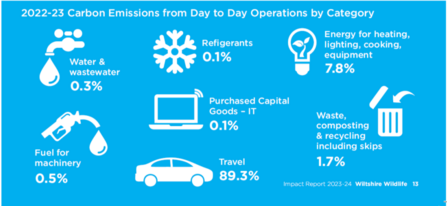Climate Change and Carbon Emissions
What are we doing?
To help limit climate change and support actions to adapt to it, Wiltshire Wildlife Trust has committed to balance its greenhouse gas emissions. The Trust aims to reduce emissions from its day-to-day operations as far as possible while increasing carbon captured and stored through land management of our nature reserves.
WWT annually calculates its emissions in line with other Wildlife Trusts, using tools developed by The Wildlife Trusts, aligned with best practice for carbon accounting and based on the Greenhouse Gas (GHG) Protocol. In the Financial Year 2022-23, GHG emissions across The Wildlife Trusts collectively were 19,539.6 tonnes of carbon dioxide equivalent (tCO2e). You can find out more about this here.
Wiltshire Wildlife Trust employs a Carbon Reduction Champion in a role shared with Wiltshire Wildlife Community Energy to complete the detailed calculations. Gathering the data helps identify opportunities to reduce emissions, alongside consideration of other factors for the Trust to meets its objectives as a conservation charity. An Annual Carbon Reduction Plan is produced which is supported by ‘Action Lists’ developed by our Sustainability and Carbon Reduction Group for areas of emissions including energy, travel and transport and procurement.
While the calculations are sometimes an imperfect measure and improve over the years, they do provide a baseline to help us reduce our emissions.
WWT Carbon Footprint
Our day-to-day operations emissions for 2022-23 were 269 tonnes of carbon dioxide equivalent (tC02e) made up of:

The largest contribution to our 22-23 emissions was travel which includes WWT vehicles, business and volunteer mileage and our staff commute. The higher figure is largely due to improved staff commute data and also reflects the large, rural area we work across. It highlighted an area of focus for a placement student from the University of Bath working with WWT this summer.
Energy consumption is a large contributor to our carbon footprint. We’re on a 100% renewable energy tariff which provides the electricity we use from wind and hydro schemes. Monitoring electricity use across our sites is crucial to identify opportunities to reduce emissions. Re-organising our main office space in Devizes helped save over 15,000 kWh electricity and last summer a renewable energy audit was carried out to explore opportunities to install additional schemes across our sites.
Operations emissions included: Scope 1 (direct) emissions are those associated with use of fossil fuel in WWT buildings, vehicles and machinery, also refrigerants used for heating and cooling*. Scope 2 (purchased electricity) emissions along with Scope 3 (indirect) emissions from waste and recycling, water used and sewerage at sites without treatment facilities, staff travel, commuting and working from home, overnight hotel stays*, volunteer travel and purchased capital goods*. Also included are emissions, auto-calculated from fuel and energy-related activities to cover the extraction, production, and transportation of fuels and energy purchased within supply chain. *New for 2022-23 calculation

The Wildlife Trusts have led on research and development of a tool to calculate emissions from livestock used for conservation grazing which gives WWT an emissions total for 2022-23 of 759 tonnes of carbon dioxide equivalent (t CO2e) using a widely accepted method. This compares to 298 (t CO2e) using an alternative approach (GWP*), which some would argue is more appropriate for the estimation of the global warming impact resulting from the emission of short-lived greenhouse gases such as methane (especially from grazing animals when grazing levels remain approximately constant from decade to decade). Conservation grazing is an essential tool for managing habitats on our nature reserves.
To provide a more complete picture and WWT ‘footprint’, we estimate the carbon captured and emitted over the year by different habitats on our nature reserves. Currently there are no international accounting or reporting guidelines on land-based greenhouse gas emissions and removals. Research into carbon exchanged by certain of The Trust’s different habitat types remains limited and with massive variation in the estimates. Adding Great Wood to our reserves in 2023 resulted in a higher figure for carbon removed during that year but as in previous years, this calculation is offered with a note of caution and conservative figures have been used in the final calculation
Our Carbon Reduction Champion also supports Wiltshire Wildlife Community Energy’s Community Fund.
If you would like to get in touch please email JessicaT@wiltshirewildlife.org
